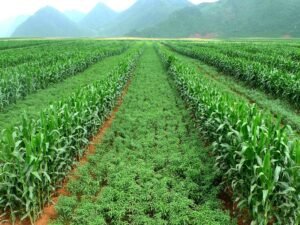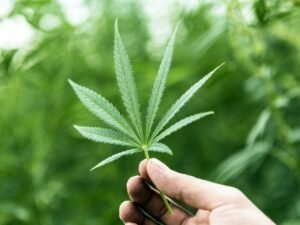Organic Farming of Coriander
Scientific name: Coriandrum sativum L.
Family: Umbelliferac
Basically Coriander is used as important food stuff in our kitchen. Although it has huge vitamins & minerals properties so it is used as herbs also. Coriander is being used as a spice since ancient times. Vitamin A is found in abundance in coriander seeds and leaves.

Dry seeds contain 112 percent moisture, 4.1 percent protein, 161 percent fat, 216 percent carbohydrate, 326 percent fiber and minerals (calcium, phosphorus and iron). It is used by grinding it or directly using the seeds for flavoring food items like pickles, sauces, sweets, curry powder etc. The volatile oil is extracted from the seeds by distillation method and is used to make aromatic liquid or aromatic soap.
Ginger farming guide for beginners.
Some of the health benefits of Coriander:
- It may help to lower the blood sugar
- Coriander offers anti oxidant material that boost our immune system
- It can help to reduce the blood pressure level.
- Coriander may protect brain health.
- It makes cure on stomach digestion process.
- It saves our body from several iinfections
- Coriander can make your skin healthier
How to add coriander into your diet?
Many of the people use coriander as raw parsley. It has huge different taste in leaves as well as fruit. Many people like to eat coriander in India. Grinding its fresh leaves is very much liked in the form of chutney. Coriander seeds are baked and used as an important pickle for pickles. Along with this, the baked seed powder of coriander is also used as a vegetable spice. Fresh coriander leaves are also used as a good garnish. It is also used to add good flavor to soups and other foods.

It is used to make green coriander chutney and to make vegetable-vegetable soups and salads tasty and attractive. Coriander or oil is used in many Ayurvedic medicines, especially in dyspepsia, dysentery, and urinary diseases.
Brinjal farming method for beginners.
In India it is mainly cultivated in Rajasthan, Andhra Pradesh, Madhya Pradesh, Tamil Nadu, Bihar, Uttar Pradesh, Karnataka and Jharkhand. It is often grown in all the states for green leaves. In India, it is cultivated in about 4 lakh hectares, which produces about 1100 lakh metric tons of coriander.
It is exported to Sri Lanka, Japan, Singapore, USA and other countries. At present there is a lot of demand for organic coriander in the world and it is available all over the country.
In organic production, the combination of fertilizers, pesticides, insecticides and herbicides made from inorganic elements is prohibited. In its place, dung manure, vermi compost, and other organic pesticides are used.
The use of fertilizers, pesticides, insecticides and herbicides made from inorganic elements in organic production is prohibited. In its place, manure, compost, vermi compost, green manure etc. are used.
Best farming method for Green Pea.
Land and climatic requirement for Coriander:
In areas with warm and mid-climate where the temperature is not high and the distribution of rainfall is fine. is successfully grown. During flowering, high temperature and strong wind affect production. Coriander can be cultivated in all types of soils which have sufficient organic content.

Improved Varieties of Coriander:
Rajendra Swati High yielding high volatile oil, fruit drying resistant, time-100 days, yield-12-14 quintals/ha
G-1 – High yielding seed big green time 112 days Yield – 11 qtl/ha
G-2 – High yielding dense leaves, time- 110-115 Day yield 15 quintal / hectare Suitable for cultivation rainfed areas, chap resistant, time- 95-105 days, yield 10 quintal / hectare
Pant Haritima Leaf and suitable for spices, green, aromatic, 12-15 qtl/ha
Indus plants are dwarf, seed strong sticking, raised and powdery ascites resistant, time – 102 days, yield 105 quintals / ha.
Other varieties – Pusa Salexon 360, Karan, CM-2.
Sowing Time & Seed Rate of Coriander:
In India sowing of coriander (for seeds) can be done from mid-October to mid-November. In early sowing high temperature damages the plants. Hence dry and cool weather remains favourable. 12-15 kg seed is required for one hectare. Keep seed rate at 20-25 kg/ha for irrigated and rainfed areas.
How can you get the best Okra (Bhendi) production?
Preparation of the field for Coriander: Make the soil turgid by stirring the field twice. Ballet will also be broken by giving Pata after July. In the last plowing mix 15-20 tonnes of decomposed cow dung per hectare in the field and mix it well. Along with this give earthworm manure at the rate of 5 quintal per hectare in the fields.
Seed sowing Coriander:
Before sowing press the seed lightly with feet and divide it into two parts and treats it by mixing 5 grams Trichoderma per kg of seed and sows the seed in the prepared field by making beds. Coriander can also be sown behind the plow. After sowing by sprinkling method add 1-2 cm of soil to the seed. Keep a distance of 30 cm between the rows. The distance from the plant to the foot is 8-10 cm. More about this source text Source text required for additional translation information.
Irrigation for Coriander:
First irrigation is done after one week and after second irrigation germination starts. The entire crop requires 4-5 irrigation. Moisture is essential during plant growth and grain formation. By the use of sprinkler irrigation yield can be enhance up to 15 to 20%.
Weed control for Coriander farming:
After 30-35 days of sowing of seed, remove the weeds by doing first intercultural operations. Do the second weeding in 50-60 days. Keep the distance of the plants 10 cm, weeding will destroy the weeds and air circulation will also be maintained in the soil which is necessary for the growth of plants.

Take care of the Coriander farming:
Irrigate the field during winter to avoid frost. Coriander crop is ready in 90-110 days. Cut the plants and dry them in the shade and after drying, separate the seeds.
Best farming methods for Tomato.
Clean the seeds after dewatering and packing them. The yield of 6-8 quintals/ha is obtained in irrigated condition and 10 to 15 quintals/ha in irrigated condition.
Yield in Coriander Farming: It gives a yield of 10-15 quintals/ha.
Insects and Prevention:
Lahi: Spray the solution of leaves of botanical substances like neem tulsi, karan etc. Beauveria is an insecticide based on the term Visiana, which works by spreading disease in insects like green worm, mahu leaf miner borer etc. For this 4-5 grams per liter of water should be dissolved and sprayed.
How to control diseasein coriander farming:
Do deep July in the hot summer. Sow healthy seeds. Treat the seed and sow it. Use Neem or Karaj Khalli in the field. So the swelling use good variety RCR 41 and seed treat.
Powdery mildew: Treatment of disease tolerant varieties CO – 3, Gujarat
Nios 1, Gujarat Dhaniya-2 and Swati.
Trichoderma which is available in the market like Monitor Bioderma, Anmol Derma, Trico S. Powdery mildew and soil borne diseases can be prevented with the use of P. bionumb flower available under the name Tricocil.
Best farming method to grow Garlic.
Organic certificate:
Organic certificate is required for cultivation of organic coriander. The organic certificate is issued for the same land, determining the veracity of the organic farming done on the land. For this detailed information should be obtained by contacting the certification institutions approved by the father from the country.

Organic certification is a 3-year program for one year and two year crop lands. Even during these years, the farmer can produce his product by organic method and feed it in the market so that he can get higher price. For a group of small farmers a system of certificates has been developed in collaboration with institutions by following organic standards completely.
Best method to grow Cauliflower in India.
Cost economics for coriander:
| Cost economics for Organic Coriander (Dhania) | ||
| Description | Rs. | |
| Land prepararion times | 2000.00 | |
| Coriander seed 12 Kg/Ha @ Rs. 80/Kg | 720.00 | |
| Rotten Mannure | 6000.00 | |
| Fertilizers | 3000.00 | |
| Seed Treatment | 100.00 | |
| Bed Preparation | 1000.00 | |
| Irrigation 5 times | 2500.00 | |
| Intercultural Operarions | 2000.00 | |
| Plant protection | 2000.00 | |
| Harvesting | 2500.00 | |
| Investment | 21820.00 | |
| Production | 15Quinatal per Ha | 1500.00 |
| Sale price | Rs. 70/Kg | 105000.00 |
| Net benefit | 83180.00 | |
| Note: This data is just to calculate cost of cultivation taken from different resources. It may varies place to place and variety of seeds. | ||




